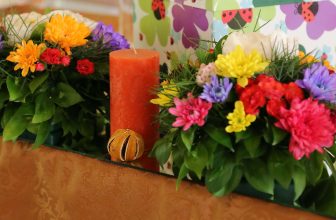How to Decorate a Large Vase
Are you tired of looking at that plain and empty large vase in your house? Want to add some personality and style to it? How to decorate a large vase is an easy way to add a pop of color or texture to any room.

Decorating a large vase can transform an ordinary space into a statement of style and personality. Whether it is a centerpiece or part of a larger decor ensemble, a well-adorned vase adds depth, texture, and color to any room. This guide will walk you through various creative and elegant ways to decorate your large vase, from choosing the right materials to styling tips that suit any aesthetic.
Whether you’re aiming for a minimalist look or a bold, artistic expression, the versatility of large vases makes them perfect canvases for your decorative flair.
What are the Benefits of Decorating a Large Vase?
Decorating your large vase has numerous benefits beyond just adding visual interest to a room. First and foremost, it allows you to express your personality and style. Whether you prefer a classic look or a more contemporary feel, decorating a large vase gives you the opportunity to showcase your unique taste.
Additionally, decorating a large vase is an affordable way to update your home decor. Instead of splurging on expensive furniture or accessories, you can simply give new life to an existing piece by decorating it with a few simple materials.
Decorating a large vase can also help tie together different elements in a room. You can create a cohesive and harmonious look by choosing colors and textures that complement other pieces in the space.
What Will You Need?
Before getting started, gather the necessary materials. Depending on your chosen decoration method, you may need some or all of the following:
- Large vase
- Paint (acrylic or spray paint)
- Wrapping paper or fabric
- Ribbons and bows
- Artificial flowers and greenery
- Decorative stones or beads
- Hot glue gun
- Scissors
- Paintbrushes
- Painter’s tape
It’s important to select materials that will suit your aesthetic preferences and the type of vase you have. For example, if you have a glass vase, using heavy decorative stones may not be ideal, as they could break or damage the vase.
9 Easy Steps on How to Decorate a Large Vase
Step 1. Clean Your Vase:
Begin by thoroughly cleaning your vase, both inside and out, to ensure that any decorations adhere properly and stand out. Use a gentle cleaner to avoid damaging the vase’s surface. Allow it to dry completely before proceeding to the next step.
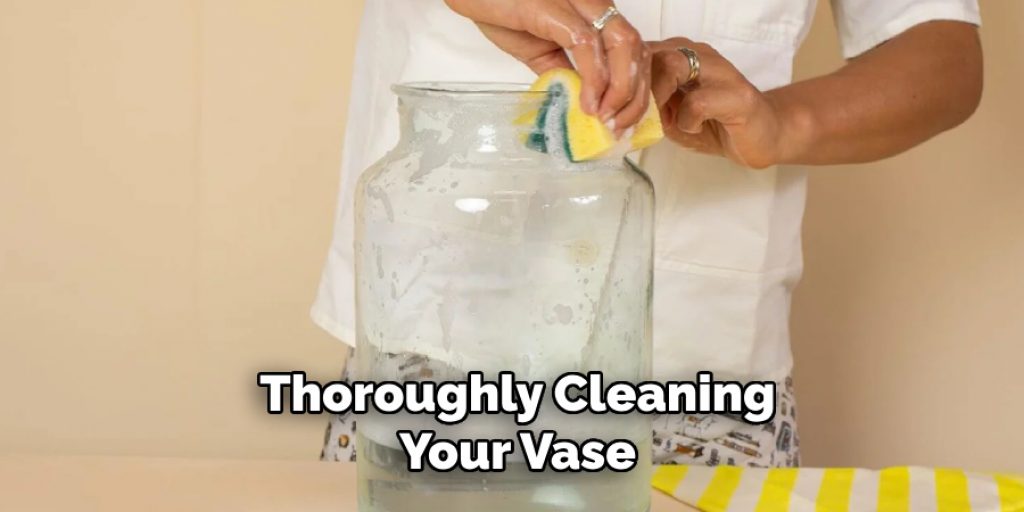
Step 2. Choose Your Theme or Style:
After ensuring your vase is clean and free of dust, decide on the overall theme or style you want to achieve. This could be anything from a rustic, natural look to something more glamorous or minimalist. Your chosen theme will guide your selection of materials and the decoration process. For instance, a beach-themed vase might feature sand and shells, while a more rustic vase could be adorned with twine and dried flowers.
Consider the existing decor in your room to ensure your vase complements it. Spend some time browsing inspiration online or in magazines if you’re unsure of what style you prefer. This initial planning stage is crucial for achieving a coherent look that reflects your personal taste and enhances your home’s aesthetic.
Step 3. Prepare Your Materials and Workspace:
Once you have decided on your theme or style, prepare your materials and workspace. Lay out all the supplies you plan to use on a clean, flat surface. Cover the area with newspapers or a drop cloth to protect it from spills or paint splatters. If you’re using paint or a hot glue gun, ensure you work in a well-ventilated area to avoid inhaling fumes.
Organizing your materials beforehand will streamline the decorating process, making it more enjoyable and less stressful. This step is especially important if you use materials that dry quickly or require a certain application sequence.
Step 4. Apply a Base Layer (If Necessary):
If you plan to paint your vase or cover it with fabric or paper, applying a base layer is essential. This step is especially important for transparent or dark vases that may show through the decoration. Use a brush or spray to apply a uniform coat of paint as the base. To cover the vase with fabric or paper, apply a thin layer of glue evenly over the vase’s surface.

Allow the base layer to dry completely before moving on to the next step. Choosing the right base color or texture can significantly impact your vase’s final look, setting the tone for the additional decorations you plan to add. Remember, this base layer also helps ensure that your subsequent decorations adhere better and stand out more prominently.
Step 5. Add Texture or Pattern:
Now that you have a base layer, it’s time to add texture or pattern to your vase. This can be achieved in various ways, such as wrapping the vase with ribbon, applying decorative stones or beads with a hot glue gun, or gluing on pieces of fabric or wrapping paper. When adding these elements, consider the overall style you’re aiming for.
For example, a minimalist vase might feature a simple geometric pattern with painter’s tape before painting over it. At the same time, a more eclectic design could include a mix of textures and materials. Be creative with this step; this is where your vase begins to truly reflect your personal style. Allow any glued or painted designs to fully dry before proceeding.
Step 6. Incorporate Color:
With the texture or pattern in place, the next step is incorporating color into your design. Color can dramatically alter the look and feel of your vase, transforming it into a statement piece that grabs attention or a subtle decoration that blends seamlessly into its surroundings. Choose colors that complement the room’s existing palette and reflect the mood you wish to create.
You can apply color through additional layers of paint, colored ribbons, or even natural elements like dried flowers. If you’re aiming for a cohesive look, consider using hues that are already present in the room. Experiment with gradients or contrasting colors for a more dynamic effect. Allow all colored elements to dry thoroughly before moving on to the next step.
Step 7. Enhance with Lighting:
If you want your vase to serve as a decorative piece and a source of ambient lighting, consider adding a string of LED lights. Wrap the lights around the vase or place them inside if the design allows. LED lights are especially effective in glass vases, where they can create a beautiful, glowing effect.

Choose warm white lights for a cozy atmosphere or colored lights to match the theme of your vase. Ensure the battery pack or plug is discreetly positioned and easily accessible for turning the lights on and off. This step can elevate your vase from a simple decorative item to an enchanting light feature that enhances the mood of any room.
Step 8. Finalize with Personal Touches:
Now that your vase has taken shape with its theme, texture, pattern, and lighting, it’s time to add those final, personal touches that make the piece uniquely yours. This could involve attaching sentimental items like keepsake charms or family photos or perhaps adding a finishing coat of sealant to protect your work and give it a polished look.
Consider how this vase will be used — as a centerpiece, perhaps, or to hold fresh flowers — and make any adjustments necessary to accommodate its function. Remember, the prime value of DIY projects like this lies not just in the aesthetic appeal of the final product but also in the personal satisfaction and meaning imbued in the item by its creator. Allow everything to set and dry completely, then step back and admire your handiwork, ready to enhance your home or be gifted to someone special.
Step 9. Display or Gift Your Vase:
With your vase fully completed, the next and final step is to decide on its placement or to whom you might want to gift it. If it’s intended for your home, find a spot where it will be most admired — perhaps on a mantelpiece, a shelf, or as the centerpiece of your dining table. When positioning your vase, consider the light sources in the room, as this can affect the appearance of its colors and textures. If you’re planning to gift it, consider the recipient’s personal style and how the vase could complement their space.
Pair the vase with a handwritten note or card explaining the thought and creativity that went into making it, adding an extra layer of meaning to your gift. Whether displayed in your home or given away, your DIY vase is a testament to your creativity, skill, and personal expression.
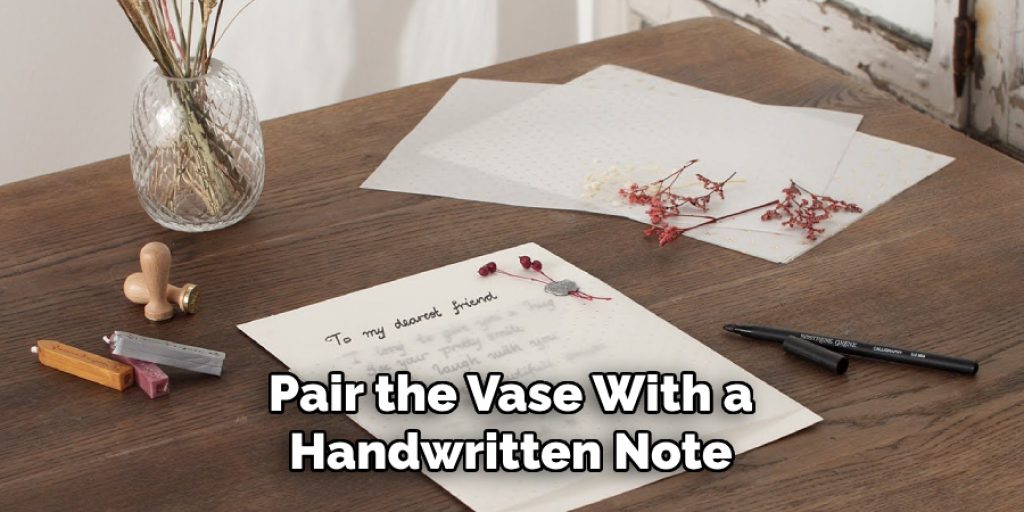
By following these simple steps, you can transform an ordinary vase into a unique and personalized piece of decor that adds character and charm to any space.
5 Additional Tips and Tricks
- Use Branches or Twigs: For a rustic or minimalist touch, fill your vase with tall branches or twigs. This not only adds height and dimension to a room but also brings an element of nature indoors. Consider painting them for added color or leaving them natural for a more organic feel.
- Layer with Sand or Stones: Create visually pleasing layers at the bottom of your vase using colored sand or decorative stones. This technique not only enhances the vase’s aesthetic appeal but also provides stability to taller decorative items placed inside.
- Incorporate Lighting: Insert a string of LED fairy lights inside the vase to transform it into a luminous decor piece. This can add a cozy ambiance to any room, making it perfect for evenings at home.
- Floating Candles or Flowers: Fill the vase with water for a more elegant decoration, and add floating candles or fresh flowers. This can create a serene and inviting atmosphere, ideal for dinner parties or special occasions.
- Wrap It Up: Customize your vase by wrapping it in fabric, yarn, or rope. This can completely change its look, matching it to your home’s decor style. For a more dramatic effect, use bold patterns or colors that pop.
With these additional tips and tricks, your vase can become a versatile and eye-catching decor piece in any room.
5 Things You Should Avoid When Decorating a Large Vase
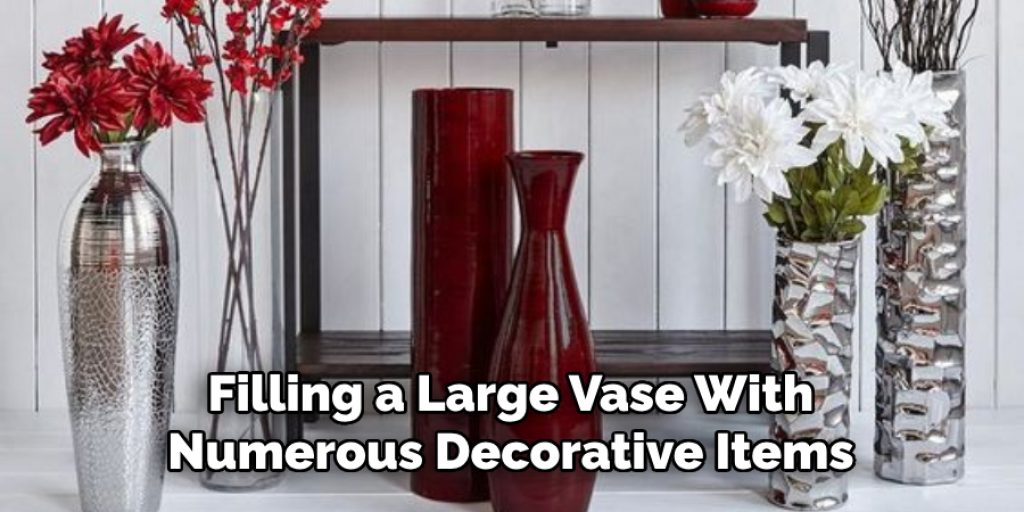
- Overloading with Decor: While filling a large vase with numerous decorative items is tempting, it can create a cluttered or overwhelming appearance. Aim for simplicity and elegance by choosing a few key pieces that complement each other.
- Ignoring Proportion and Scale: When selecting items to place in or around your vase, consider their size and shape relative to the vase. Disproportionate decorations can unbalance the vase’s visual appeal, making it look awkward or misplaced.
- Using Perishable Items Without Care: Incorporating organic materials like fruit or fresh flowers can add a lively touch, but ensure they’re replaced regularly to avoid decay and unpleasant odors.
- Neglecting the Vase’s Material: Be mindful of the material your vase is made from. Certain decorations or adhesives may damage surfaces, particularly on vases made from delicate materials like glass or porcelain.
- Overlooking the Vase’s Original Beauty: Sometimes, the vase itself is a work of art. Over-decorating can detract from its inherent beauty. Before adding any embellishments, consider whether they enhance or overshadow the vase’s design and character.
By avoiding these common mistakes, you can ensure that your large vase is used to its full potential as a stunning and tasteful decorative element in your home.
5 Different Theme Ideas for Decorating a Large Vase
- Botanical Garden: Embrace the beauty of nature by filling your vase with fresh or faux greenery, such as ferns, succulents, or eucalyptus branches. This theme brings a touch of tranquility and freshness to any space.
- Nautical Bliss: For a coastal-inspired look, decorate your vase with items like seashells, starfish, and driftwood. You can also add a pop of color with blue or turquoise glass beads or pebbles.
- Modern Metallic: Incorporate metallic elements such as gold or silver spray-painted branches, copper wire spheres, or metallic beads to create a sleek and sophisticated look.
- Rustic Charm: Add a touch of warmth and coziness to your home with a rustic theme. Fill your vase with dried twigs, cotton branches, or wheat stalks, and tie it off with burlap ribbon or twine.
- Monochrome Madness: For a simple yet striking look, stick to one color for all your decoration choices. This could be anything from white for a clean, minimalist feel to bright red for a bold and daring statement. Experiment with textures and shapes within your chosen color to add interest and depth.
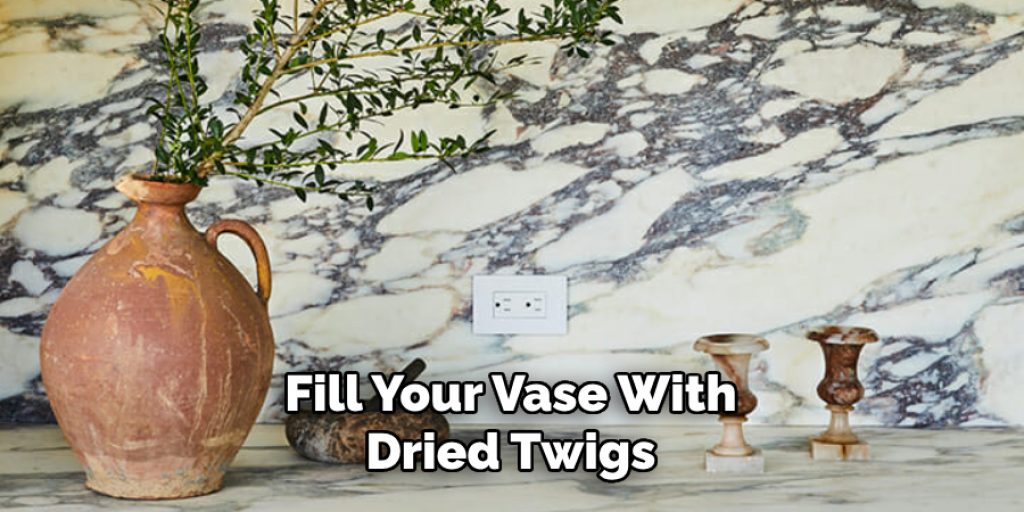
By exploring these different theme ideas, you can create a unique and personalized look for your large vase that reflects your personal style and adds character to your home decor.
What are the Best Places to Display Large Vases?
- Entryway: A large vase can make a statement when you walk into your home. Place it on a console table or shelf in the entryway to welcome guests with style.
- Living Room: Place a large vase on a coffee table, sideboard, or fireplace mantel to add visual interest and height to your living room.
- Dining Room: A large vase can make a striking centerpiece for your dining table, especially when filled with fresh flowers or candles.
- Bedroom: To bring a touch of elegance and tranquility to your bedroom, place a large vase on your dresser or nightstand. Fill it with scented flowers or twigs to create a calming atmosphere.
- Outdoor Spaces: Don’t limit your large vase to indoor areas. Place it on a patio or balcony, and fill it with outdoor-safe decorations like faux plants, shells, or stones for a touch of nature in your outdoor spaces.
With these ideas in mind, you can find the perfect spot to display your large vase and elevate the overall aesthetic of your home.
What Can Damage a Large Vase?
- Direct Sunlight: If your vase is made of materials like glass or ceramic, prolonged exposure to direct sunlight can cause fading or discoloration.
- Extreme Temperatures: Rapid temperature changes can crack or damage delicate vases, especially those made of glass or porcelain. Avoid placing them near heating vents or air conditioning units.
- Water Damage: If using fresh flowers or water for floating candles, be careful not to spill or overflow, as this can cause damage to surfaces and the vase itself.
- Improper Cleaning Methods: Using harsh chemicals or abrasive materials when cleaning your vase can damage its surface. Stick to gentle cleaning solutions and soft cloths.
- Handling With Force: Large vases are delicate and should be handled carefully. Avoid dropping or knocking them against hard surfaces, which can lead to chips, cracks, or even breakage.

By taking precautions and handling your large vase with care, you can preserve its beauty and longevity for years to come.
Conclusion
In conclusion, how to decorate a large vase presents a unique opportunity to enhance the aesthetic appeal of any space within your home. Whether you’re aiming for a look that’s understated and elegant or bold and dynamic, the key lies in understanding the balance between the vase’s inherent beauty and the decorative elements you choose to add.
By avoiding common pitfalls such as overloading with decor, ignoring proportion, or neglecting the vase’s material, and by exploring thematic ideas such as a botanical garden, nautical bliss, modern metallic, rustic charm, or monochrome madness, you can transform a simple vase into a striking statement piece.
With these strategies and considerations in mind, you can confidently use large vases to bring together any room’s decor, creating cohesive, stylish, and inviting spaces throughout your home.




